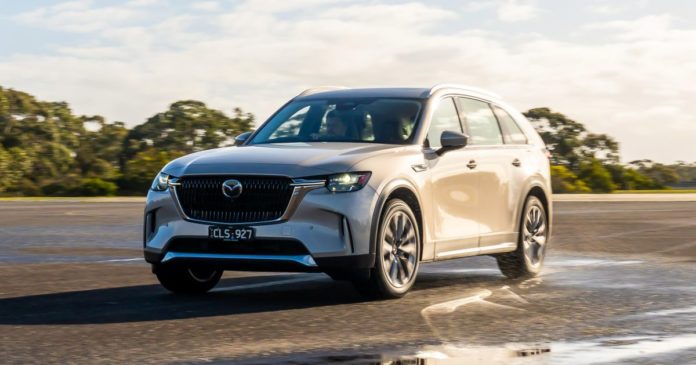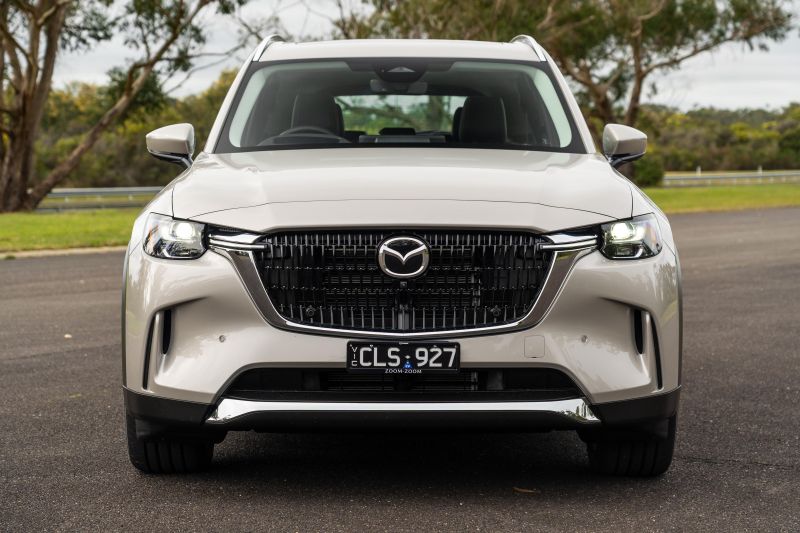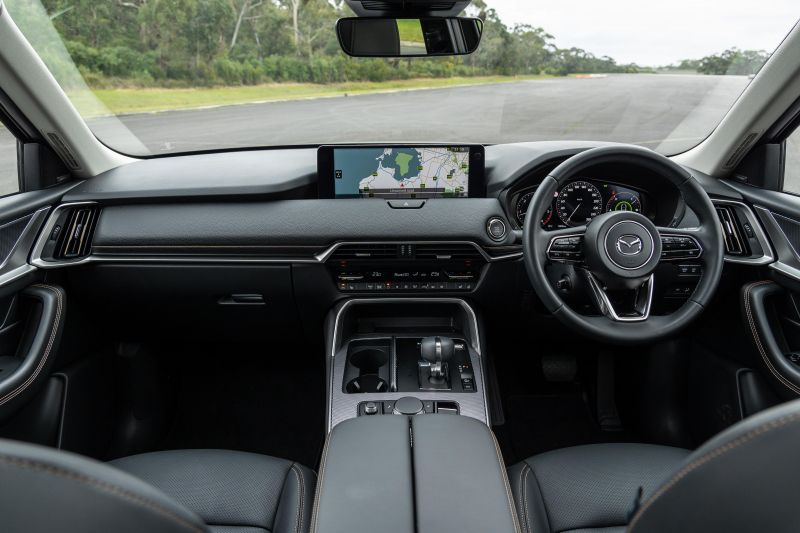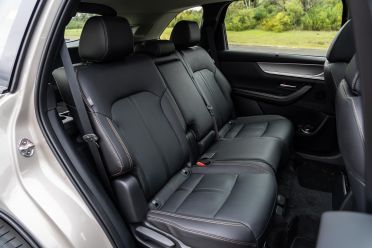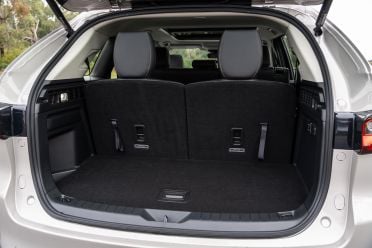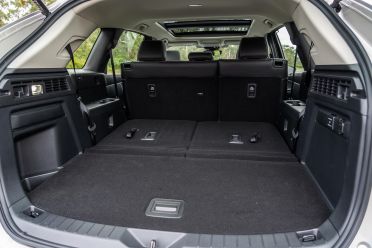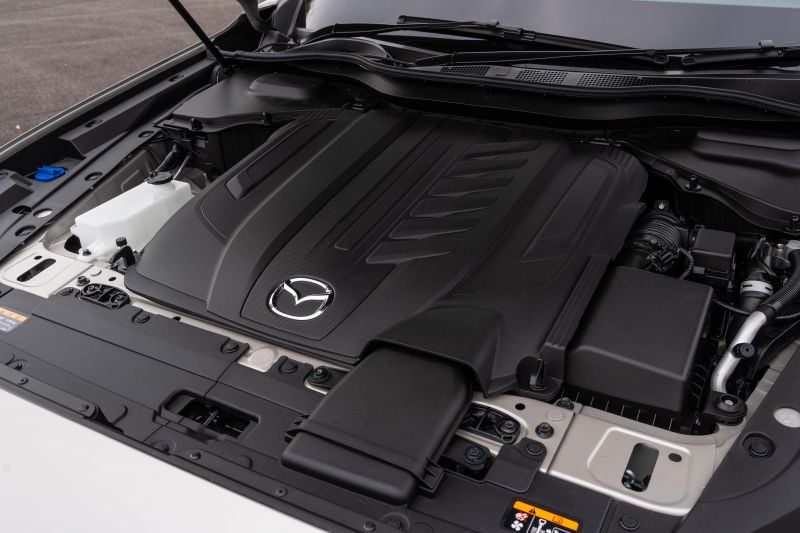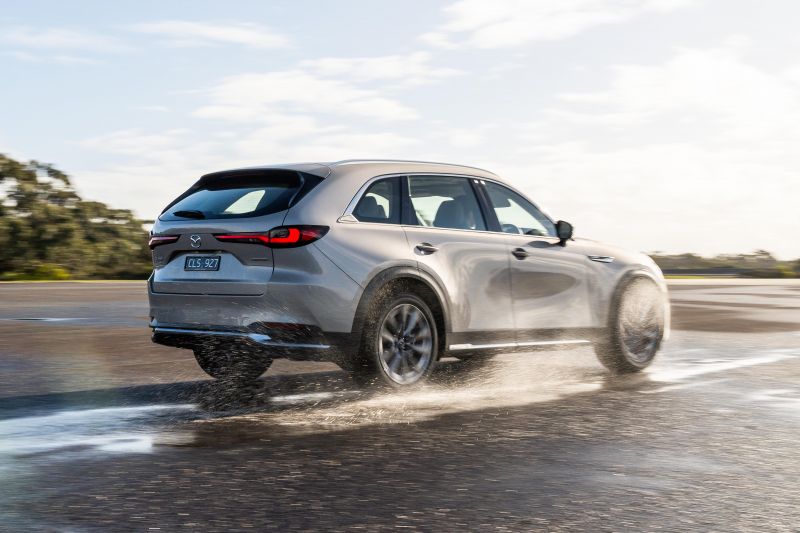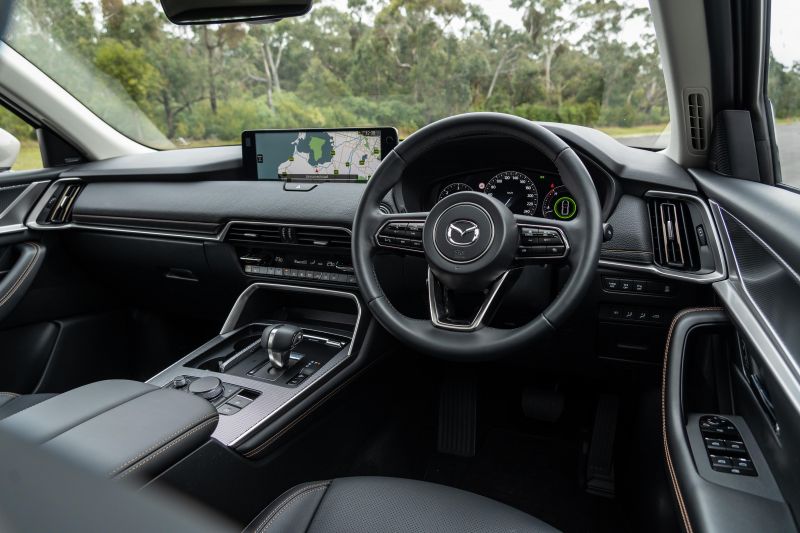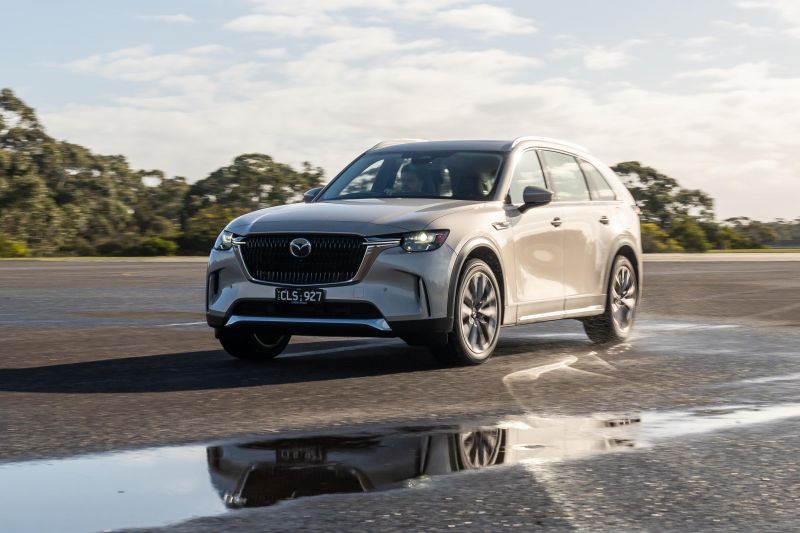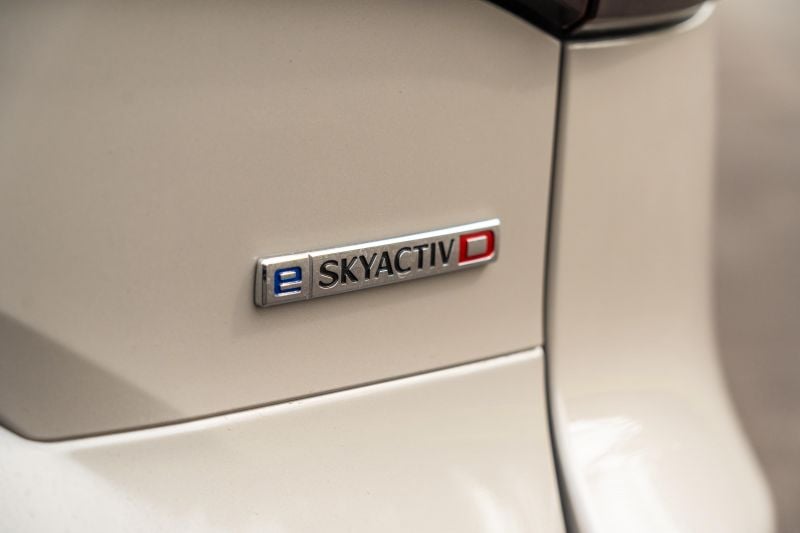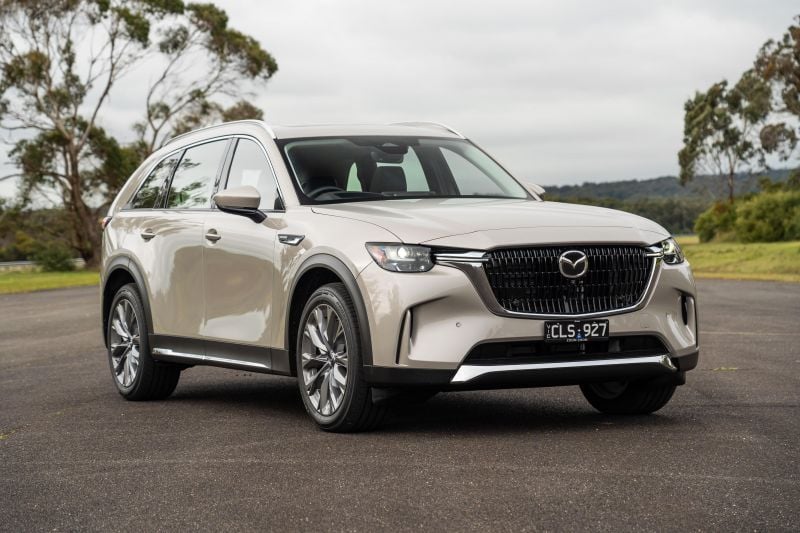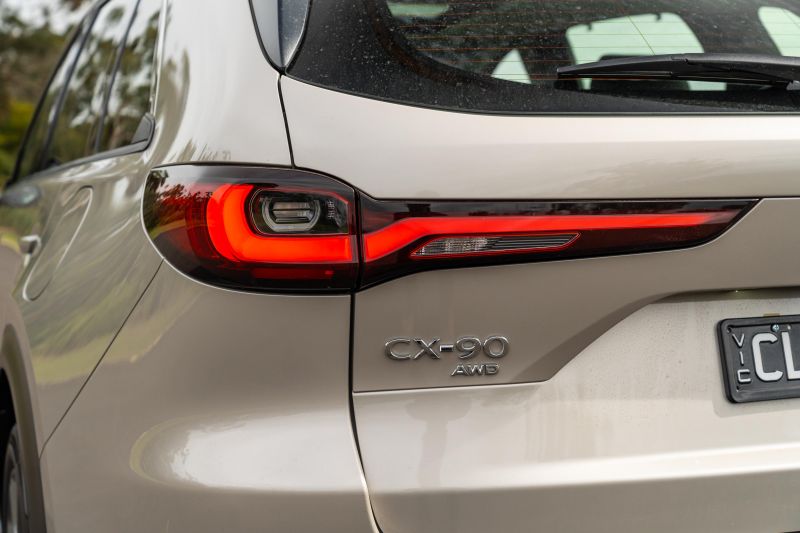The Mazda CX-90 is a big car with a big job to do.
Not only is it meant to compete with everything from the Hyundai Palisade and Nissan Pathfinder to the Audi Q7 and Genesis GV80, it’s also a proper test of Mazda’s ability to produce a premium vehicle that sits in a premium price bracket.
Starting at $80,000 on the road and topping out at six figures fully optioned, the Mazda CX-90 is well and truly the biggest and most expensive model Mazda has ever produced, and finds itself amongst some very stiff competition in the large SUV space from both mainstream and premium brands.
Compared to the now discontinued CX-9, Mazda claims the CX-90 is up to 47 per cent more powerful, up to 31 per cent torquier and up to 40 per cent more fuel efficient. That all comes from newly-developed six-cylinder petrol and diesel engines with 48V mild-hybrid technology, which debuted in the smaller CX-60.
Here on test we have the 2024 Mazda CX-90 D50e GT, the mid-spec diesel variant which lists for $85,000 before on-road costs and arguably serves as the ‘just right’ model in the range should you not need absolutely everything in the catalogue.
Can Mazda duke it out with the big boys (and girls)? Read on to find out.
How does the Mazda CX-90 fare vs its competitors?
View a detailed breakdown of the Mazda CX-90 against similarly sized vehicles.

Mazda
CX-90
How much does the Mazda CX-90 cost?
The CX-90 was recently subject to range-wide price rises of $600 following its initial launch in Australia.
2024 Mazda CX-90 pricing:
- Mazda CX-90 G50e Touring: $74,400
- Mazda CX-90 D50e Touring: $76,400
- Mazda CX-90 G50e GT: $85,335
- Mazda CX-90 D50e GT: $85,400
- Mazda CX-90 D50e Azami: $93,320
- Mazda CX-90 G50e Azami: $94,435
Prices exclude on-road costs
To see how the CX-90 shapes up against its rivals, use our comparison tool.
What is the Mazda CX-90 like on the inside?
If you’ve sat in the CX-90, there’s not much different here other than an impression of more width.
The general design is pretty much the same, with an upright dashboard and mostly straight lines. There’s also the same wide centre console, toggle-light switchgear for the HVAC system, and the split-lid centre armrest cubby.
Like the CX-60, the lower trims get regular leather and a heavily grained insert on the dashboard that to me looks a little like toadskin. It definitely lacks the pizzazz of the Azami models with either the optional SP or Takumi packages.
Stepping to the GT over the Touring brings some desirable items like a 12.3-inch fully digital instrument cluster as well as a larger 12.3-inch Mazda Connect infotainment system, which offers touch functionality for smartphone mirroring only.
You also get other niceties like heated front seats, a heated steering wheel, a 12-speaker Bose premium audio system, and a big panoramic sunroof. It all definitely ups the ambience over the Touring; although, that’s a $10,000 jump.
As we’ve found with other Mazda models running this infotainment system, it’s relatively well-featured and is generally responsive. The clean interface is very old BMW-esque; though, the lack of connected functionality might be a sticking point for some spending this much money on what’s marketed as a ‘premium product’.
I generally just used wireless Apple CarPlay which worked seamlessly for the most part, bar the odd occasion where the CX-90 was a little slow to hook up to my phone.
Storage up front is pretty good, with a deep centre cubby, a pair of cup holders under a weighted lid, a shelf for your phone that doubles as a wireless phone charger, and door bins that can hold a standard bottle.
Perceived build quality is also pretty good too, as we’ve come to expect from the Japanese brand. It may not quite be up there with some of the premium German brands or Genesis, but it still has an old-school Lexus kind of feel to it. I’d personally opt for the Revera Stone light leather option because I find black to be a little boring.
The second row is huge, as you’d expect from a car so large. I’m 6’1 and space for someone my size behind my preferred driving position is bordering on palatial.
Families with teenagers will have no problems with the space on offer, and you can even fit three across without much fuss. This is where the American-focused origins come into play. You also get amenities like a third zone of climate control with separate controls behind the centre console, as well as a fold-down centre armrest with cupholders.
The second row is also heated on the outboard positions, and there are the requisite ISOFIX and top-tether points where applicable. You can also slide and recline the second-row seats to open up more space in the rear.
In the third row, the CX-90’s increased size over the CX-9 opens up adult-friendly accommodation for short trips, and kids will be very happy back there. There are additional air vents in the rearmost seats, an improvement over the CX-9, as well as cupholders and USB-C outlets for each passenger.
With all three rows up, there’s 257L of space, an improvement of 59L over the CX-9. Drop the third row and this space expands to 608L, measured to the height of the seatback and including the underfloor storage space.
Drop this row, and there’s 2025L, measured to the ceiling and again accounting for the underfloor storage space. Under the boot floor there’s a space-saver spare.
What’s under the bonnet?
D50e versions of the Mazda CX-90 feature a 3.3-litre inline six turbo-diesel mild-hybrid, which develops 187kW (3750rpm) and 550Nm (1500-2400rpm).
The M Hybrid Boost system comprises a 48V mild-hybrid system that “supports the engine at lower speeds while delivering enhanced environmental performance by using regenerative braking to replenish the onboard battery”.
Unlike some other mild-hybrid systems, Mazda hasn’t confirmed exact outputs the M Hybrid Boost function contributes when supporting the engine. Drive is sent to a rear-biased all-wheel drive system via an in-house eight-speed automatic transmission.
Mazda’s new eight-speed automatic features a multi-plate clutch and integrated electric motor-generator in place of a hydraulic converter as an input clutch. In essence, the electric motor in both mild-hybrid and plug-in hybrid versions (with mechanical clutch), take the place of a conventional torque converter.
The company claims this helps to improve fuel efficiency and throttle response over a conventional automatic. While not available from launch, Mazda will also add a 240kW/500Nm 2.5-litre plug-in hybrid drivetrain shared with the smaller CX-60, offering 50-60km of EV driving range.
All CX-90 models in Australia offer a 2000kg braked towing capacity, with 150 towball download maximum.
How does the Mazda CX-90 drive?
Where some mainstream-branded competitors can feel a little strained with their naturally aspirated V6s or four-cylinder diesel options, the CX-90 feels a lot more muscular in line with higher-end European competition.
Diesel has copped a bad rep in the past decade, but there’s still something to be said about the low down shove and efficiency of a good oiler, particularly in the medium and large segments.
The 3.3-litre inline six diesel in the CX-90 is effectively the same power unit offered in the CX-60, and it’s more than up to task with hauling this 2.2-tonne (kerb) SUV around town and on the highway.
As we’ve found previously, the drivetrain is a little rough around the edges at times, with some noise intrusion from the electric motor and transmission permeating the cabin at lower speeds and the occasional jerk through shifts or as the mild-hybrid system gets moving and fires up the diesel engine.
While it ain’t perfect, overall performance and driveability from this six-pot oiler is pretty strong.
All 550Nm is on tap from just 1500rpm, which is the same sort of shove on offer from European V6 diesels offered by the Audi Q7 and Volkswagen Touareg (500Nm-600Nm). That means acceleration is strong and relatively effortless whether you’re riding solo or with a packed car.
It’s really what separates the CX-90 from the likes of the Hyundai Palisade and Kia Sorento, which only offer a four-cylinder diesel with 147kW and 440Nm. Further, the Mazda doesn’t have that rattly, agricultural note that is a signature of four-cylinder diesels.
Gun it and the CX-90 hustles along impressively, with a beefy powertrain noise that sounds partially augmented by the speakers – which is somewhat reminiscent of BMW’s sweet inline-six diesels.
It’s also impressively efficient. Mazda officially claims 5.4L per 100km on the combined cycle, and we were able to achieve to high-sixes to low-sevens without really trying, which is mighty good for a vehicle this big in mixed driving.
In typical Mazda fashion it handles pretty well too despite its size, with accurate and connected steering and responsive drive controls that give it a more athletic feel.
That’s not to say it’s as harsh as the CX-60, which has been widely criticised for its firmness, but it’s definitely leaning on the sportier side of things compared to a range of competitors. Driving it through inner-city Melbourne, it definitely has a more Americanised suppleness compared to its smaller stablemate.
Considering this thing is 5120mm long and 1994mm wide, there’s definitely no hiding its size but it corners with the enthusiasm of a smaller vehicle. You’ll rely heavily on the big mirrors and surround camera too because parking this thing in the city can get a little tricky in tight spaces.
On that, the heavy and direct steering means the CX-90 can require a bit more muscle when manoeuvring at lower speeds, which is worth noting but not a deal-breaker.
The CX-90 also offers a decent range of driver assistance systems, but unlike the CX-60 you cannot option the full suite of features on the mid- and entry grades of this flagship SUV, which seems like an oversight.
Adaptive cruise control and lane keep assist headline the standard inclusions on the base Touring, as well as surround cameras and front and rear parking sensors. The GT tested here adds what Mazda calls ‘adaptive LED headlights’ which feature a dynamic high-beam function akin to Matrix LED technology offered by other brands.
What’s disappointing is that you can only get the semi-autonomous Cruising & Traffic Support system with lane centring and Traffic Jam Assist on the flagship Azami, despite it being available as an option on lower grades of the CX-60. Considering the CX-90 GT is $90,000 on the road, it seems silly that this just isn’t standard.
That said, the fitted technology all works pretty well, though the constant binging and bonging of Mazda’s front and rear cross-traffic alerts can get a little annoying if they’re constantly set off in urban environments.
What do you get?
CX-90 Touring highlights:
- 19-inch silver metallic alloy wheels
- 360-degree view monitor
- 7.0-inch TFT LCD multi-information meter display
- 10.25-inch Mazda Connect display
- 8-speaker audio with DAB+
- Active driving display
- Adaptive cruise control
- Advanced keyless entry
- Tri-zone climate control with independent rear control
- Apple CarPlay, Android Auto (Wireless and USB)
- Auto-dimming rear-view mirror
- Blind Spot Monitoring incl. Vehicle Exit Warning
- Body colour exterior mirrors
- Driver monitor
- Exterior mirrors
- Power adjustment
- Auto fold
- Heating
- Auto dimming
- Memory function
- Front, rear parking sensors
- Front bumper with gloss black bar grille
- Gloss black side pillar garnish
- Glove box illumination
- Hands-free power tailgate
- Heated seats (front)
- Leather seats
- Front seat power adjustment, driver memory
- Leather shift knob
- Leather side door trim with door courtesy lamp (Front)
- Leather steering wheel
- Auto LED headlights incl. High Beam Control
- Map reading spot lamps
- Overhead console with sunglass holder
- Rear console with LED lamp, USB-C
- 150W AC outlet
- Rear door window sunshade
- Satellite navigation
- Smart Brake Support (AEB) with Turn-across traffic
- Vanity mirror with lamp
- Wireless phone charger
CX-90 GT adds:
- 12.3-inch widescreen display
- 12.3-inch TFT LCD driver display
- 21-inch silver metallic alloy wheels
- Adaptive LED headlights
- LED ‘bright’ signature running light
- Electric steering wheel adjustment
- Heated seats (front, rear)
- Heated steering wheel
- Interior foot lamp (driver and passenger)
- Leather side door trim with door courtesy lamp (front, rear)
- Panoramic sunroof
- Personalise system (auto restoration of settings)
- Premium Bose audio incl. 12 speakers, amplifier
- Rear combination lights with signature illumination
Is the Mazda CX-90 safe?
The Mazda CX-90 hasn’t been crash-tested by ANCAP yet, and is therefore unrated.
Standard safety features include:
- Autonomous Emergency Braking (AEB)
- Pedestrian, Cyclist detection
- Junction assist
- Adaptive cruise control
- Auto high-beam
- Blind-spot monitoring
- Front, rear parking sensors
- Lane keep assist
- Secondary Collision Reduction System
- Vehicle Exit Warning
- 360-degree camera system
CX-90 GT adds:
CX-90 Azami adds:
- 360-degree cameras incl. See-Through View
- Cruising & Traffic Support
- Adaptive cruise control
- Lane centring assist
How much does the Mazda CX-90 cost to run?
Mazda covers its entire range with a five-year, unlimited-kilometre warranty.
G50e models will require maintenance every 12 months and 15,000 kilometres, while the D50e models have shorter 10,000km gaps between services. In D50e models, the first five services are capped at $478, $643, $975, $643 and $478; for a total of $3217 over five years.
As noted earlier, we saw indicated fuel consumption in the high 6.0L to low 7.0L/100km in mixed conditions. It’s a mighty good figure given the size, and competitive with what you’d achieve in more expensive European competitors.
You can thank the aggressive 48V mild-hybrid system for this, which does its best to shut off the engine from about 20km/h as you come to a stop in traffic and will also will turn the engine off when coasting to save fuel.
CarExpert’s Take on the Mazda CX-90
You’ll certainly make an impression with the CX-90 – it’s a pretty hard thing to miss in the car park.
The CX-9 was still a solid car so many years after it launched, and the CX-90 builds on that with a more muscular drivetrain and improvements to practicality and tech to bring it up to speed with today’s competiton.
It still has some rougher edges to iron out, such as certain unrefined elements in the driving experience at low speeds; more net-based infotainment functionality; and we’d also like to see more of Mazda’s driver assistance technologies offered on more trim variants.
My personal pick of the engine choices is the diesel tested here; it’s torquier and far more efficient which no doubt is a factor for families conscious of running costs. Longer service intervals for the oiler would be nice; though, and it’s a shame the oiler doesn’t get a power boost over the CX-60 like the petrol six does in the CX-90.
Has Mazda produced a flagship worthy of taking business away from established premium marques? Well, given the price gulf between this CX-90 and a base Audi Q7 (from $116,400), let alone a BMW X7 (from $167,900), it can be viewed as a much more affordable alternative, but it’s not quite up to the same level as those vehicles just yet.
If you’re looking at a CX-90 I’d strongly ask whether you want the additional kit enough to spend six figures on the Azami, such is the list of standard equipment in the GT tested here.
Click the images for the full gallery
BUY: Mazda CX-90
MORE: Everything Mazda CX-90

